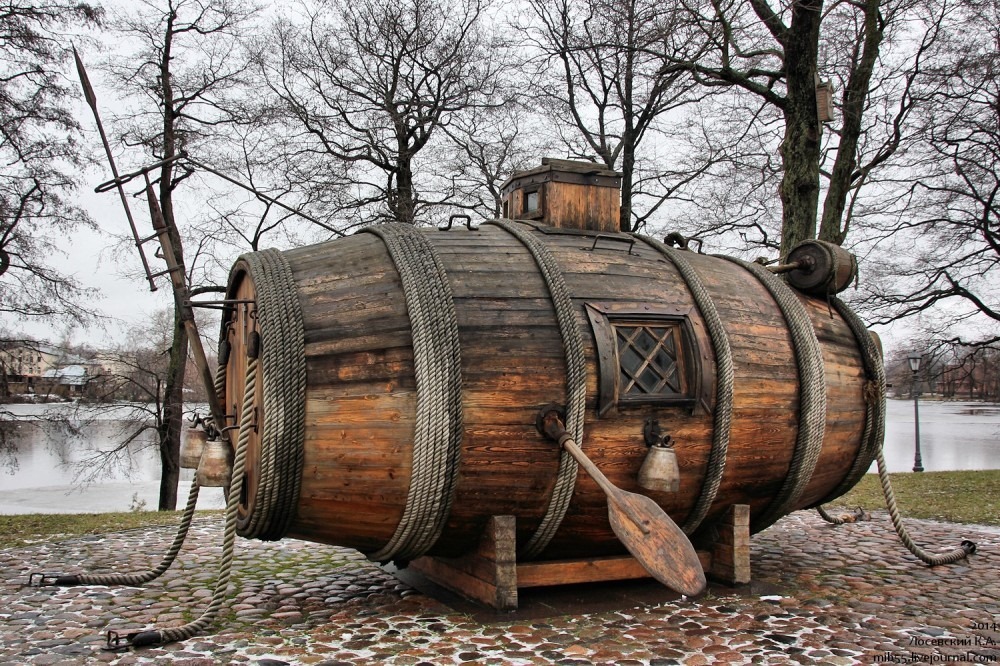The possibilities of a submersible boat that could cruise below the water’s surface undetected and ambush enemy ships has fascinated military leaders of the world since antiquity. Legend has it that Alexander the Great himself had got into a primitive form of submersible to conduct underwater reconnaissance.
One of the first concepts for an underwater rowing boat was drawn up by an Englishman named William Bourne in 1578, but it was not until 1620 when the plans were eventually realized by the Dutchman Cornelius Drebbel. Drebbel’s submarine, built of wood and propelled by oars, could stay underwater for several hours. Floats with attached tubes brought air from the surface to the crew below. When he demonstrated the submarine’s capabilities by diving on the River Thames and staying underwater —as rumor has it— for three hours, the thousands of Londoners who had assembled on the banks to see the feat perform were convinced the men had perished.

A replica of Yefim Nikonov’s submarine, believed to be the first military submarine built, stands at Sestroretsk, near St Petersburg, on Neva River. Photo credit: Serguei Fadeev/Wikimedia
The Dutch poet and composer Constantijn Huygens, who witnessed the tests, later wrote how this “bold invention” could be used at times of war, attacking and sinking enemy ships lying in apparent safety at anchor. Like Huygens, many others recognized the submarines’ military potential although it would take another one hundred years before the first military submarine could be built.
In 1718, a Russian carpenter named Yefim Nikonov wrote to Peter the Great claiming that he could build a “secret vessel” that could sail underwater and destroy all enemy ships with cannons. Curious and interested, the Tsar invited Nikonov to Saint-Petersburg and asked him to get down with the construction.
Nikonov finished constructing the model in 1721, and tested it in Peter’s presence, who was so pleased with the results, that he ordered Nikonov to build a full-sized secret battleship.

Nikonov’s submarine was built out of wood and shaped like a barrel. It was armed with “fire tubes”, a weapon akin to flame-throwers. The submarine was supposed to approach an enemy vessel, put the ends of the “tubes” out of the water, and blow up enemy ships with some combustible mixture. In addition, he designed an airlock for aquanauts to come out of the submarine and to destroy the bilge of the ship.
The first trial of the submarine was conducted in autumn 1724. It was a disaster. The submarine sank, hit the bottom and broke the bilge. Nikonov himself, along with four oarsmen, were inside. It was only by a miracle that the crew managed to save themselves.
Peter was supportive and encouraged Nikonov to improve the design. But failures continued to plague Nikonov, especially after the death of his principle patron, Tsar Peter. In the spring of 1725, the second test of the “secret ship” ended in a fiasco, as did the third one in 1727. Finally, the patience of the Admiralty Board of the Imperial Russian Navy snapped. Nikonov was charged with abuse of public funds, reduced to the status of common carpenters and sent off to work at another shipyard on the Volga River.

Photo credit: Alex Panfiloff/Panoramio

Photo credit: zavodfoto.livejournal.com
The first successful use of a military submarine during actual combat happened during the American Revolutionary War in 1775. The submarine called Turtle was designed by an American inventor David Bushnell. It was a hand-powered egg-shaped device that could accommodate a single person, and it was the first submarine capable of independent underwater operation and movement. The Turtle dived by allowing water into a bilge tank at the bottom of the vessel and ascended by pushing water out through a hand pump. Hand-cranked propellers provided vertical and horizontal movement with a maximum speed of 4.8 km/h. The vessel contained enough air for about thirty minutes of operation.
During the American Revolutionary War, the Turtle, operated by Sgt. Ezra Lee, tried but failed to affix a charge on the hull of a British warship, HMS Eagle. According to reports of the attack, Lee was discovered before he could carry out the task forcing him to abandon the submarine. However, the only records documenting the attack are American. There are no British records of an attack by a submarine during the war, which has caused some historians to doubt the authenticity of the story. Some believe that the entire story around the Turtle was fabricated as disinformation and morale-boosting propaganda.
Replicas of the Turtle's are now on display at several museums across the United States, as well as the Royal Navy Submarine Museum at Gosport, England.


Full sized mockup of the Bushnell "Turtle" at the U.S. Navy Submarine Force Museum and Library, Groton CT. Photo credit: divemasterking2000/Wikimedia
Sources: Wikipedia / Russiapedia / rusnavy.com



Comments
Post a Comment